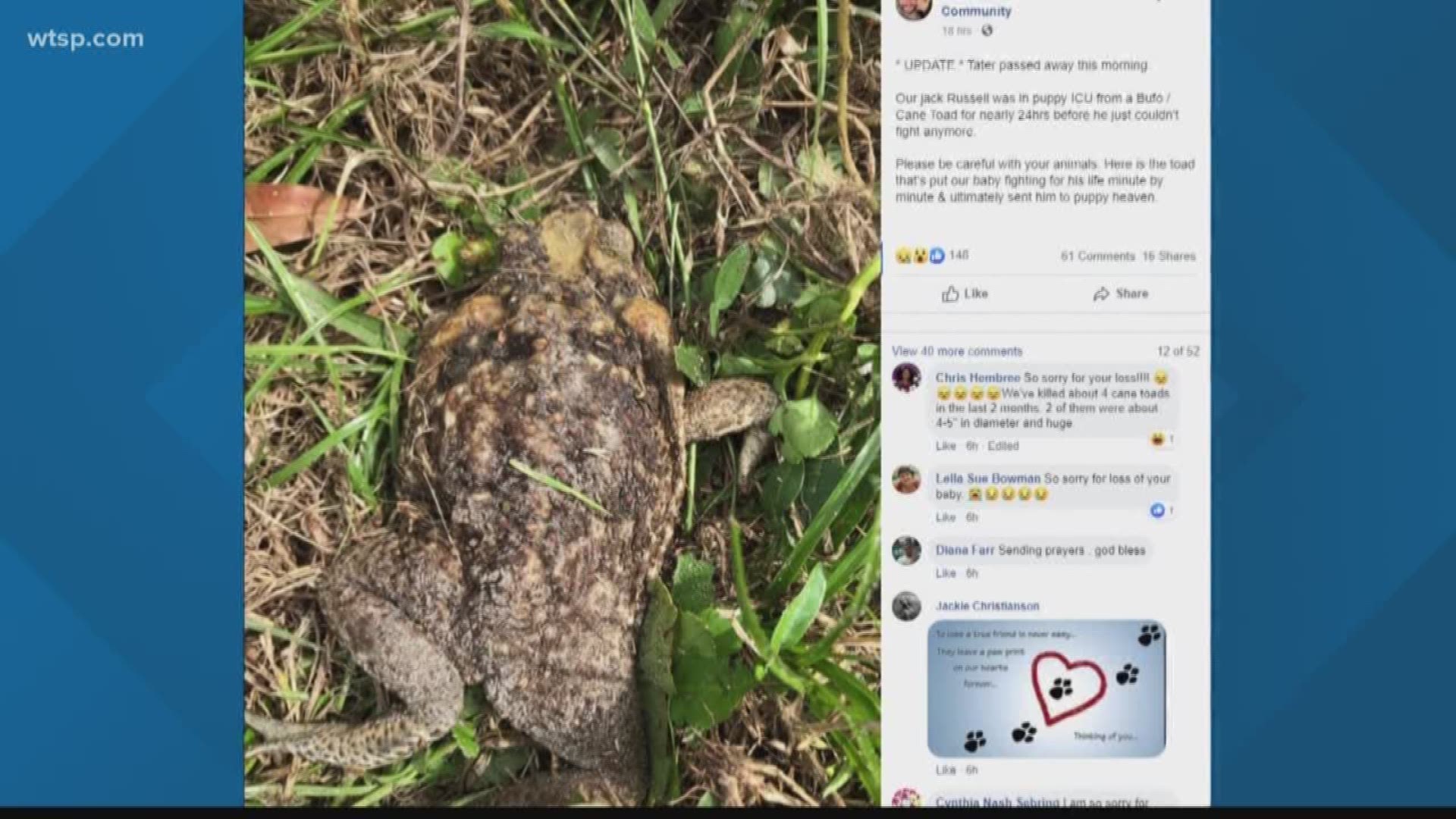ST. PETERSBURG, Fla. — The giant toads -- commonly called Bufo toads or Cane toads -- are fat, palm-sized reptiles that secrete a poison toward the top of their heads. It's a toxic, milky substance that can irritate humans if it gets onto skin and kill dogs or cats if it's swallowed.
According to Florida Fish and Wildlife, Cane toads breed year-round in standing water, streams, canals and ditches.
The toads are not native to Florida.
They were introduced in South Florida to control pests in sugar cane fields -- but the population has exploded.
They can be gray, brownish-gray, olive-brown, red-brown or yellowish and can vary from 4 to 9.25 inches in length.
Their venom, which is secreted when the toad feels threatened, can be especially toxic to pets. Death in some animals may occur by cardiac arrest within 15 minutes.
"Dogs will chase cane toads and bite them, which can release toxins from the toads' saliva glands," said Dr. John Gicking of BluePearl Specialty and Emergency Pet Hospital. "Dogs can die, especially if they eat the toad."
"The classic signs are drooling, brick-red gums and irritation of the mouth," Gicking said. "Dogs also can become hyperactive and even have seizures."
If you think your pet has had an encounter with this deadly species:
- Immediately and vigorously flush your pets' mouth with water to prevent further absorption of the toxin.
- Be sure to hold the mouth open and downward to keep your pet from swallowing more of the toxin.
- Get your pet to your veterinarian right away.
- While on your way, call ahead so that they can prepare for emergency arrival.
- Protect yourself with nonabsorbent gloves and protective eyewear, and wash your own hands and all other exposed areas
How to spot (and hear) the Bufo toad
Any toad in Florida larger than four inches likely is not a native species, according to the University of Florida.
They are naturally warty creatures with varying shades of tan to brown. In addition to their size, the Bufo toad can be identified by the triangular-looking glands on its shoulders. This is the area where the poison is secreted.
The native southern toad has more of an oval-looking gland. Plus, native toads have ridges or "crests" on top of their heads -- the Bufo toad does not, UF says.
They're loud, too, sounding like an "idling diesel engine."
What can pet owners do about them?
Dr. Gicking recommends pet owners keep a close eye on their animals while outside -- and for dogs, keep them on a leash.
There is a humane way of killing the invasive toad and limiting its spread.
UF recommends to rub or spray 20-percent benzocaine toothache gel or sunburn spray (not 5-percent lidocaine) on the toad's lower belly. It will become unconscious in a few minutes. From there, the toad can be put in a plastic bag and placed in a freezer.
After 24 to 48 hours, it will be dead.
You can find more on the invasive species from UF IFAS Wildlife Ecologist Dr. Steve Johnson here.
What other people are reading right now:
- Amid national unrest, family still seeking justice after father dies in TPD custody
- Joe Biden clinches Democratic nomination to face Trump in November
- DC mayor renamed street near White House 'Black Lives Matter Plaza'
- 57 Buffalo Police Emergency Response Team members resign from special position
- Tropical Storm warning issued for part of Florida Panhandle
- What's open in Florida? Phase 2 begins Friday
- Deputies: Man pulls machete from his pants as protest ends
FREE 10 TAMPA BAY APP:
►Stay In the Know! Sign up now for the Brightside Blend Newsletter



